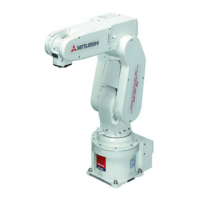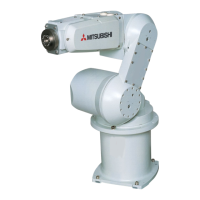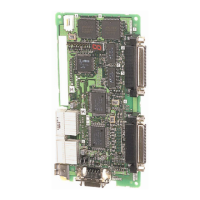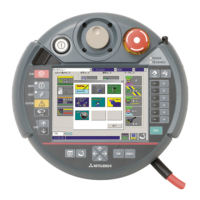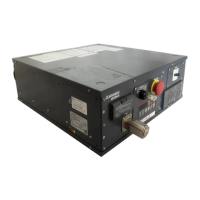Do you have a question about the Mitsubishi RV-2AJ and is the answer not in the manual?
| Manufacturer | Mitsubishi |
|---|---|
| Type | Industrial Robot |
| Payload | 2 kg |
| Number of axes | 6 |
| Axes | 6 |
| Reach | 504 mm |
| Repeatability | ±0.02 mm |
| Installation | Floor, Wall, Ceiling |
Explains the contents and purposes of various manuals included with the product. Covers Safety Manual, Standard Specifications, Robot Arm Setup & Maintenance, Controller Setup, Detailed Explanation of Functions and Operations, MOVEMASTER COMMANDS, and Troubleshooting.
Details common precautions for robot handling, system design, and ensuring operator safety. Includes CAUTION, WARNING, and DANGER statements.
Lists standard configuration parts for the robot arm and their quantities. Also refers to separate 'Standard Specifications' for optional products.
Details the steps for unpacking, transporting, mounting, grounding, and connecting the robot arm to the controller.
Explains the necessity and methods for setting the robot's origin point for accurate operation, including pendant installation and data input.
Explains how to perform manual movements (jog operation) of the robot arm using the teaching pendant to verify correct operation.
Details the installation procedures for solenoid valve sets for various robot types, including connection methods.
Provides instructions for installing the pneumatic hand set, including component configuration and connection steps.
Explains the installation of the motorized hand set, covering hand adapter, curl cable, and connector connections.
Details the installation of hand input/output cables and hand curl tubes for connecting hands and sensors.
Outlines daily and periodic inspection schedules to ensure long-term product performance, prevent trouble, and maintain safety.
Lists detailed daily and periodic inspection items for the robot arm, including procedures and remedies for identified issues.
Details the inspection, maintenance, and replacement procedures for the J5-axis timing belt, including replacement criteria.
Identifies lubrication points for robot axes and provides specifications for grease types, amounts, and intervals.
Details various methods for resetting the robot's origin, essential for high-accuracy operation.
Explains configuration flags (RIGHT/LEFT, ABOVE/BELOW, NONFLIP/FLIP) that indicate robot arm posture.
